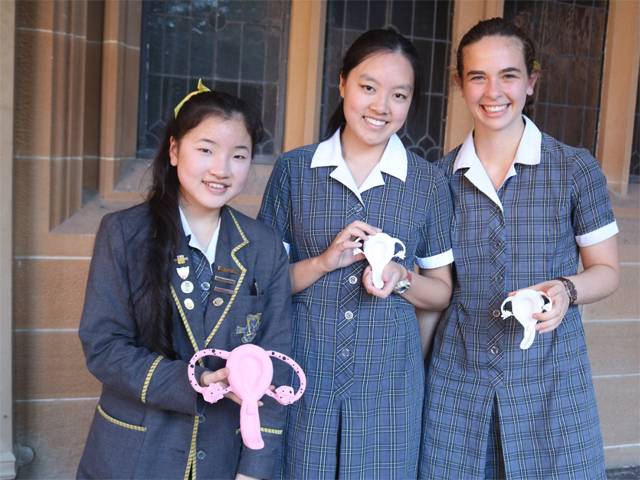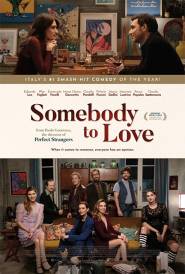Kambala Students Endometriosis Treatment Interview

An Innovative Approach for the Treatment of Endometriosis
Four Year 10 students have developed an innovative approach for the treatment of endometriosis, a debilitating condition faced by millions of women worldwide that currently has no cure.
The girls attend Kambala in Sydney's East, Emily Su, Emily Shen, Alex and Priya.
As part of the University of Sydney's 2019 BioChallenge, the team was tasked with identifying and researching a problematic area of medical science, and were then asked to 'bioengineer' a method that would solve the problem.
The team's approach is to convert stem cells to aid the reprogramming of blood cells, a conversion method currently in effect in Japan. The team's idea then takes this existing method to a new level, and hopes their idea could lead to creating new tissue which would replace endometriosis scarring. Their idea would also be to grow a new uterus in the lab using this method.
Every year an increasing number of women and girls are diagnosed with endometriosis, with many more suffering in silence. Endometriosis has long been a disease ignored by medicine and science, and so far there is no explanation of the disease, nor is there a cure. The girls believe women's health should receive more attention.
Women with endometriosis typically experience damage to internal reproduction organs such as the uterus, fallopian tube and ovaries due to endometrial lesions, scarring and cysts. It is characterised by the uterine lining spreading to areas outside the uterus, and may spread to nearby organs such as the bowel, pelvic lining, diaphragm and bladder, sometimes fusing organs together. This can lead to chronic pain, digestive issues and infertility.
Interview with Priya Bahra, Emily Su, Emily Shen and Alex Bako
Question: Can you tell us about your innovative approach for the treatment of endometriosis you developed? How does this particular treatment work?
Priya Bahra, Emily Su, Emily Shen and Alex Bako: For our idea on the treatment of endometriosis, our team looked to integrate and adapt current medical innovation to an issue that has been historically overlooked by an industry dominated by men.
Endometriosis is a disease of the female reproductive system, where endometrial tissue - which normally lines the inside of the womb - develops outside the uterus, typically in the ovaries and fallopian tubes. The misplaced tissue continues to shed with every menstrual cycle and forms painful cysts that can severely reduce the woman's quality of life.
To find a treatment to this serious, yet overlooked issue we decided to draw inspiration to existing stem cell technology. Our solution idea also synthesised other biotechnologies including 3D bioprinting and reproductive transplantation technology.
Basically, we decided to use Induced Pluripotent Stem cells (IPCs) sourced from the patient to artificially create a female reproductive system in the lab. We thought that it would be best to source blood or skin cells from the patient and dedifferentiate them using various non-integrating methods.
To program them into the specialised cells of reproductive organs, we agreed on using two different methods; exposing the stem cells to already matured reproductive cells (a process known as extrinsic inductive specialisation) and adding progesterone and oestrogen (the catalysts for female reproductive maturation). However, we realise that this part of the solution involves a lot of guesswork, so we stress that more attention and scientific research needs to be dedicated to the female reproductive system, to fill gaps in our knowledge.
After the cells have been specialised into that of reproductive tissue, they need to be configured into the shape and structure of the actual organs. We decided to use 3D bioprinting technology which allows for the precise layering of cells. After that, the new, lab-grown female reproductive system needs to be implanted back into the patient- endometriosis free.
Question: How did the four of you go about creating this approach to endometriosis?
Priya Bahra, Emily Su, Emily Shen and Alex Bako: We had the idea of using stem cells to approach endometriosis, as it is an area of medical technology that is currently being researched in other areas of medicine, and that we are all interested in. We then talked with our mentor, Dr Stuart Fraser, who we were assigned through the programme.
Dr Fraser is a researcher and lecturer in the School of Medical Sciences at the University of Sydney, who has researched physiology, molecular embryology, stem cells, and endometriosis. We were really lucky to be partnered with such a knowledgeable mentor. After we proposed our idea to him, he suggested using iPS stem cells, or induced pluripotent stem cells. These are made from blood cells from the patient's own body, which are then dedifferentiated into pluripotent stem cells. This significantly reduces the risk of rejection when the new reproductive system is transplanted.
The next step was to decide how we would specialise the cells into reproductive cells. After some research, we decided on two methods. Firstly, we proposed extrinsic inductie specialisation, a process in which the stem cells are exposed to mature reproductive cells, and specialise due to signals between these cells. Another method is adding catalysts for embryonic development of the reproductive system - the hormones oestrogen and progesterone.
These cells would be grown around a structure 3D printed from biomaterial, to shape the tissue or organ. Dr Fraser also told us about a similar research project he was running in which students created in vitro prostates from iPS. We thought that this technology would be an effective solution for endometriosis - affected areas could be removed and replaced with tissue or organs grown from iPS stem cells.
Question: What originally inspired you to research Endometriosis and create a treatment?
Priya Bahra, Emily Su, Emily Shen and Alex Bako: We were searching for a shortcoming in the medical world that we would be able to fix. Endometriosis is a very prevalent disease - one in ten Australian women suffer from this debilitating condition. It causes cysts and severe pain, scarring and fusing of tissue, nausea, fatigue and a disrupted menstrual cycle. Despite its prevalence and severity, it is not very well-known or well-researched. Endometriosis has historically been disregarded and overlooked by a predominantly male society, and it still is today.
There is still a stigma around talking about reproduction in general, especially reproductive disorders. Little research has been done into it by the scientific community - we don't even know its causes, let alone an effective solution. By researching endometriosis, we were able to raise awareness for and possibly find a treatment for this disease.
Question: Are you able to tell us about your presentation of this treatment to the panel at University of Sydney's MacLaurin Hall?
Priya Bahra, Emily Su, Emily Shen and Alex Bako: For our presentation as the University of Sydney's MacLaurin Hall, we were very excited and nervous to be presenting in front of some amazing figures from the world of bio-technology, including Professor Hala Zreiqat - an incredibly inspiring woman and pioneer of biomedical 3D printing and regenerative medicine. We also felt very honoured to be presenting in front of an audience of other teenagers who, like us, were motivated to use science and engineering to look for solutions to serious diseases.
For our presentation, we spoke for several minutes about the problem and our solution to endometriosis. We used a variety of prototypes, including a handmade clay model of a diseased reproductive system, and a 3D printed uterus. We wanted our presentation to not only be informative, but also an engaging way to raise awareness for endometriosis- because we knew that despite how serious the disease is, most of the audience had probably never heard about it.
Interview by Brooke Hunter
MORE





